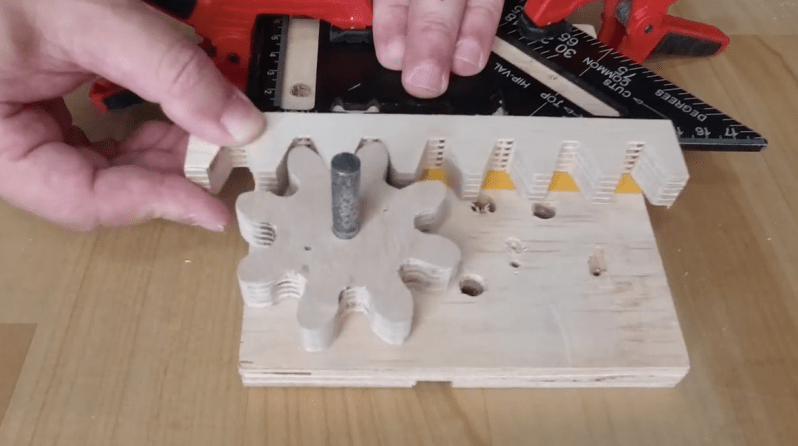Typically, most of the gears we use in our life are made of plastic or metal. However, wood gears can do just fine in some simple roles, and they’re utterly pleasant to make, as this video from [botto bie] demonstrates.
With steady hands, it’s easy to make basic gears by hand with basic tools and a printer. You just need the help of a spur gear generator to produce the required outlines for you to follow. [botto bie] uses the online tool from Evolvent Design which will spit out DXF or SVG files as you desire.
Basic woodworking techniques are used to produce the gears, and they prove simple and effective. A rack is produced by first applying a involute tooth template with paper to a rectangular piece of wood. A series of circular and table jigsaw operations are then used to cut out the required material to produce the rack. A variety of toothed gears are produced in a similar fashion.
If you’re lacking a CNC machine or a 3D printer, this can be a great way to experiment. Bonus points if you use your wooden geartrain as part of some kind of exciting mechanism, like an automated marble run or musical contraption. Video after the break.

















The generation gap is widening.
https://www.youtube.com/watch?v=oNuhr3htNWs
I follow his website which is http://www.woodgears.ca since I once googled whether you can you make gears out of wood. I don’t think he did youtibe, maybe youtube didn’t even exist back then.
He does almost exclusively YouTube these days – and he’s really interesting to watch, very different from most “YouTubers”
The cool kids just watch Matthias second channel now
For three:
https://hackaday.com/2011/04/27/wonderhowto-inteview-of-matthias-wandel/
https://hackaday.com/2015/12/01/matthias-builds-a-belt-sander/
https://hackaday.com/2021/11/22/shop-built-rig-measure-strength-of-wood-accurately/
Wooden gears were pretty common in old windmills, couldn’t get huge cast iron gears in the 16th century, but wood literally grew on trees.
https://www.youtube.com/watch?v=9BjFjKeYKDo&t=9s
Beautiful! Thanks for posting this!
The gears in old windmills here in the netherlands are also made from wood. Most of the times from two different types. The wheel is a softer wood, the teeth are from a specific type of hard wood and can be replaced if worn out.
Inkscape also does a good job of generating gears, and laser cutting them from plywood sure produces nice results. Add an alignment pin hole and you can laminate them to required thickness if you need thicker gears.
I saw a steam engine set up to drive a dynamo in a museum in Glasgow recently, where the main transfer gearing between the engine and the dynamo was a whole stack of very precisely offset spur gears, so the result was a rough approximation of a helical gear, but without the thrust effect that a helical has: multiple gears were in different states of contact with each other.
Laminating thinner layers also allows you to stack them cross grain for greater strength.
I keep telling myself that I need a 3D printer or CNC to accomplish greater work, and then I watch someone do things like this with tools that I already have, and I hang my head in shame.
I know what you mean….
https://www.boredpanda.com/funny-cake-fails-expectations-reality/?media_id=757741
Thanks! But…
“This page isn’t working
http://www.boredpanda.com redirected you too many times.”
It finally worked.
Thanks for the LOLs!
:P
For the newbies in gear making, the gear profile @05:08 is severely undercut, easily recognisable from the harp corner halfway the flank of the tooth. For a gear with a 20 degree pressure angle (standard for metric gear) this happens for gears with < 17 teeth.
There are two simple general ways to prevent this. Either shift the profile a bit, or increase the pressure angle.
And as others have mentioned. This video does not add much to the work of Matthias Wandel, but some repetition and duplication every now and then is a good thing I think.
FreeCAD also has a gear profile generator. You may have to install a plugin for it though.
This website seems to have some nice info with details about profile shift.
https://www.tec-science.com/mechanical-power-transmission/involute-gear/profile-shift/
Wooden gears can work very well for a _very_ long time.
The tower clock at Brocklesby Park, made by John Harrison (yes, the Longitude clock man) has been running continuously since 1722. So the clock has been running longer than the United States.
It is made almost entirely of wood.
Also, there are many wind and water mills throughout the world running with wooden gears, so they are not limited to low-power clock use. Though I doubt that many of the mill gears are original, inherent to the nature of such drivetrains is that you can replace teeth and pinion rods as-required.
For people with less patience using a laser cutter is a great way to create gears. Not only can you have them customized but you can have really large gears which get pretty expensive otherwise. You can also easily add rack and pinion or geared half circles in your design for things like gimbals.
As the gear can be part of other components it reduces part count and assembly complexity.
If you need thicker gears use locating pins to stack them precisely. Just some 1mm holes and nails in the right thickness will do.
Plywood works just fine. Add wax or soap as lubricant but they also work without. You can compensate for the lower strength of wood by making the gears (and gear teeth) bigger.
I have used wooden gears in my cocktail robot https://hackaday.io/project/27966-flipper
If you’re interested in this, be sure to check out Matthias Wandel on Youtube. He has been doing woodworking “form an engineering perspective” on youtube for over a decade.
I remember when I got into woodworking and had so many “unusual” questions in my mind. Then I bumped onto Wandel’s channel and after a binge watch I had 90% of my questions answered.
His gears stuff: https://www.youtube.com/@Matthiaswandel/search?query=gears
Channel: https://www.youtube.com/@Matthiaswandel